The ideal number of hives for a new beekeeper is two. While it might seem counterintuitive, starting with two hives instead of one dramatically increases your chances of success, provides invaluable learning opportunities, and helps prevent the common discouragement of losing your only colony in the first year.
The most critical mistake a beginner can make is starting with a single hive. The goal of your first year isn't maximum honey production; it's learning the craft and successfully overwintering a healthy colony. Starting with two hives is the single best strategy to achieve that goal.

The Pitfall of Starting with Just One Hive
The logic of starting with a single hive to minimize cost and effort is tempting but ultimately flawed. This approach introduces significant risks and removes your most powerful learning tool: comparison.
The Inevitability of Loss
Colony loss is a reality for even experienced beekeepers. A new beekeeper managing their first colony is particularly vulnerable to mistakes.
If that single colony dies, your beekeeping journey is over before it truly begins. You are left with empty equipment and no bees, forcing you to start from scratch the following year.
The Lack of a Benchmark
With only one hive, you have no frame of reference. Is your queen laying well? Is the colony's population growing at a healthy rate? Are they foraging effectively?
Without a second colony to compare against, answering these fundamental questions becomes guesswork. You won't know if a behavior is normal or a sign of a serious problem.
The Challenge of Problem-Solving
When a problem arises in a single hive—such as a failing queen or a weak population—your options are limited and often expensive. You may need to purchase a new queen or a package of bees.
Having a second, stronger hive provides resources you can use to solve problems in the weaker one.
Why Two Hives Are the Strategic Choice
Starting with two hives transforms beekeeping from a game of chance into a managed learning experience. It provides a safety net, a control group, and a source of emergency resources.
A Built-in Control Group
With two hives, you can directly compare their development. If one is thriving while the other is struggling, you have a clear indication that the weaker hive has a problem that needs investigating.
This side-by-side comparison accelerates your learning curve exponentially. You quickly learn to identify what a healthy, productive colony looks like.
The Power of Resource Sharing
A strong hive can be used to support a weak one. This is one of the most powerful advantages of having a second colony.
You can move a frame of brood (eggs and larvae) from the strong hive to the weak one to boost its population. If one hive loses its queen, you can use a frame with fresh eggs from the other hive to allow the bees to raise a new emergency queen.
Building Confidence and Momentum
Successfully managing two hives builds confidence. Even if one struggles, the success of the other keeps you engaged and motivated.
If both hives thrive, you can potentially expand to three or four hives the following spring, starting your second season with significant momentum.
Understanding the Initial Investment
While starting with two hives is the recommended strategy, it's important to be aware of the practical commitments.
The Upfront Cost
The primary trade-off is the initial cost. You will need two complete hive setups, two packages of bees, and protective gear. While this is a larger investment, it protects you from the total loss of a single-hive investment.
The Time Commitment
Managing two hives does not take double the time of one. Once you are at your apiary and have your equipment on, inspecting the second hive adds only a marginal amount of extra time to your routine.
Initial Equipment Needs
For each hive, you will need the basic components (bottom board, hive bodies, frames, inner and outer cover). It is also wise to purchase at least one honey super per hive from the start. This ensures you are prepared if you experience a strong nectar flow.
How to Apply This to Your Start
Your decision should be based on your primary goal for the first year. The consensus is clear, but your personal context matters.
- If your primary focus is maximizing your chance of success: Start with two hives. This is the unequivocal best practice for risk management and learning.
- If your primary focus is the absolute minimum initial cost: You can start with one hive, but you must understand and accept the significant risk of total failure and the steep, isolated learning curve.
- If your primary focus is ambitious growth: Start with two or even three hives. This gives you more resources to work with and a higher probability of being able to split your colonies and expand in your second year.
Ultimately, starting with two hives sets you up not just to keep bees, but to become a skilled and resilient beekeeper.
Summary Table:
| Starting Scenario | Risk Level | Learning Opportunity | Key Outcome |
|---|---|---|---|
| One Hive | High | Limited | High chance of total failure and discouragement |
| Two Hives (Recommended) | Low | High (built-in comparison) | Accelerated learning and a safety net for success |
Ready to start your beekeeping journey with the best chance of success?
Starting with two hives requires the right equipment from the start. HONESTBEE supplies commercial apiaries and beekeeping equipment distributors with high-quality, durable beekeeping supplies through our wholesale-focused operations.
Let us equip you for success. Contact our team today to discuss your hive setup needs and get a quote.
Visual Guide

Related Products
- Professional Drop-Style Hive Handles for Beekeeping
- Professional Galvanized Hive Strap with Secure Locking Buckle for Beekeeping
- Professional Engraved Round Hive Number Tags for Beekeeping
- Heavy-Duty Nylon Beehive Hive Strap with Stainless Steel Cinch Buckle
- Versatile Ratchet Hive Strap with S-Hooks for Secure Fastening
People Also Ask
- Why is proper beekeeping equipment important? Essential for Safety and Hive Health
- What types of gloves are available for beekeeping? Choose the Right Protection for Your Hive
- What parts of bee equipment should be painted? A Guide to Protecting Your Hive and Your Bees
- What equipment do I need to start beekeeping? The Essential Beginner's Guide
- What is beekeeping equipment? Essential Tools for Commercial Apiaries & Distributors



















